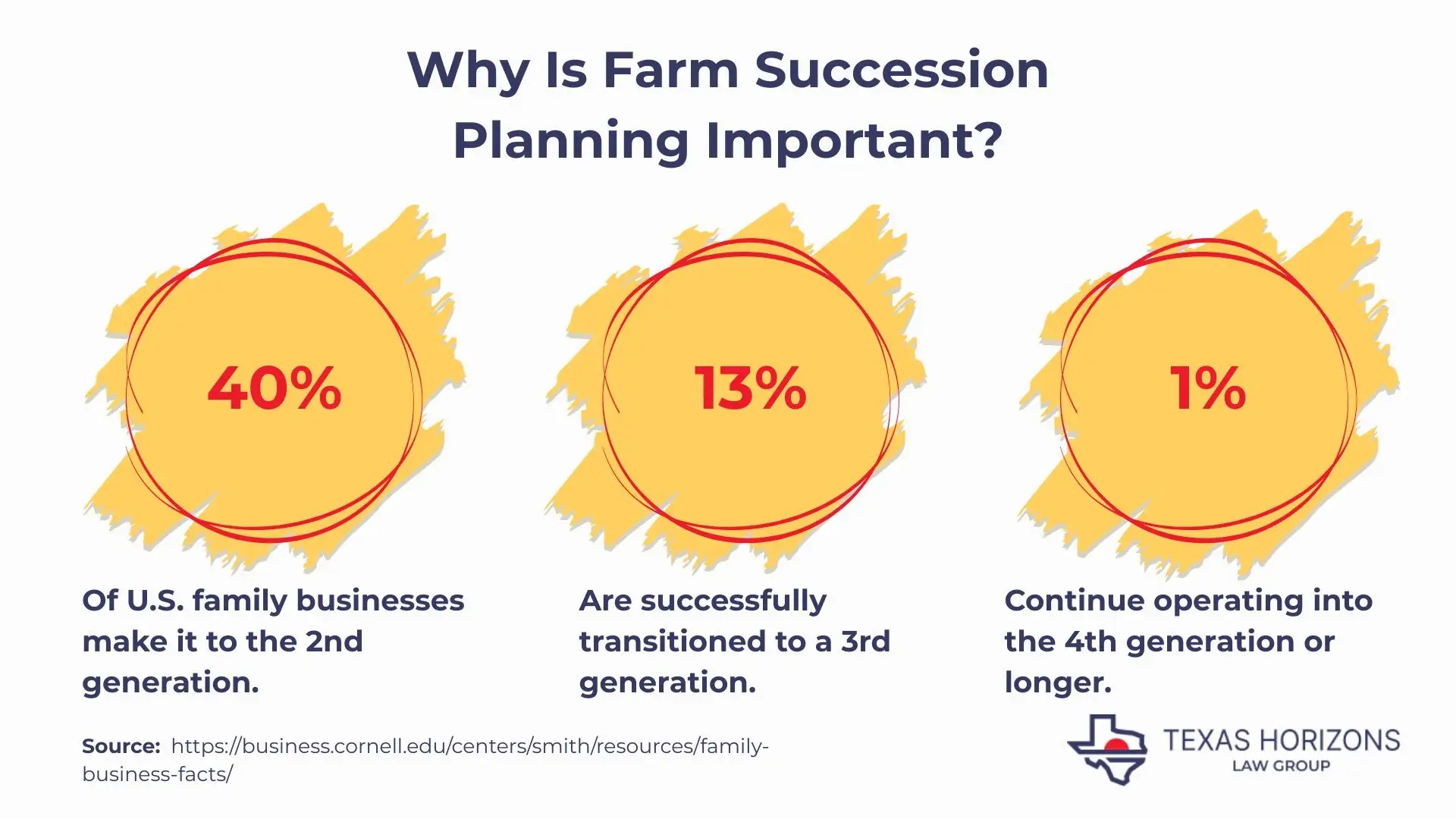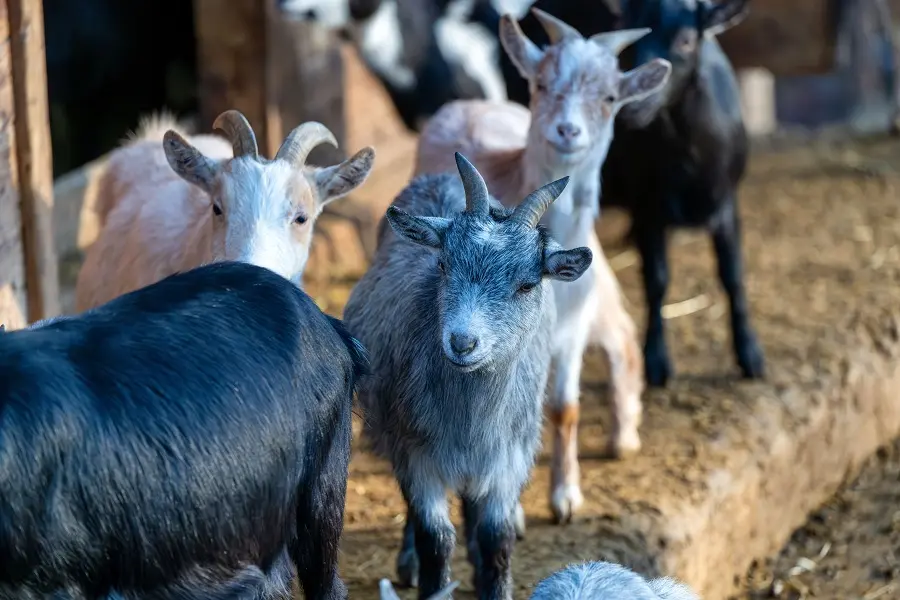Farm succession planning stands as one of the most challenging yet essential processes for agricultural families. For many Texas farmers and ranchers, the land represents not just their livelihood but their legacy — a precious resource meant to sustain future generations.
As Texas estate planning attorneys, we often witness how proper planning can preserve family harmony while ensuring continued agricultural productivity.
This comprehensive guide explores everything you need to know about transitioning your farm operation to the next generation successfully.
What Is a Farm Succession Plan?

Farm succession planning is the process of transitioning farm ownership, management, and assets from one generation to the next. Unlike typical business transitions, farms combine personal residence, business operations, and family heritage in ways that make succession particularly complex.
A well-crafted farm succession plan addresses:
- Asset transfer strategies
- Management transition timelines
- Equitable treatment of farming and non-farming heirs
- Tax implications and minimization strategies
- Retirement income for the current generation
Information You Need Before Planning Farm Succession
Before making your plan, gather information in these three areas:
Your Goals and Family Wishes
- Write down what you want for the farm's future.
- Ask each family member what they'd do with the farm.
- Compare everyone's ideas to find common ground or conflicts.
Remember that your succession goals should prioritize your retirement needs. While passing the family farm to the next generation, you might gradually transition management responsibilities. Still, you may need income from certain assets (like cell towers, billboards, mineral rights, or rental properties) to support your retirement.
Consider what matters most to you personally. If your home holds significant meaning, you might want to keep it in the family. Perhaps you wish to donate to certain charities or have requirements about how the transferred land should be used.
Legal Documents

- Collect any existing wills or trusts.
- Find paperwork for any business entities you've created.
Financial Information
- Create a simple balance sheet showing assets, debts, and net worth.
- Gather loan documents showing what you owe.
- Collect insurance policies and coverage information.
Family Records
- Create a complete roster of relatives, with contact details.
- Include birth dates and ID numbers (Driver's License, Social Security, etc.) for each person.
- Document information for spouses and in-laws, too.
Operation Details
- Identify active participants in daily farm work.
- Clarify decision-making roles and responsibilities.
- Document any existing business structures.
- Inventory all farm property and equipment.
Ownership Inventory
- List everything owned, from personal items to machinery.
- Note exactly how each property is legally owned.
- Include non-farm investments and assets.
Now, let's look at the different types of farm transition plans.
Single Successor Farm Transfers

This represents the most straightforward scenario. With a single heir, there's less concern about family disagreements and reduced overall risk. However, you should still:
- Provide ongoing guidance as you age
- Ensure your heir is prepared to take over operations
- Create a formal will
- Recognize that other family members might still dispute their exclusion
Multi-Heir Agricultural Transitions
Multiple successors mean greater planning challenges. Talk openly with everyone — farming interests change over time. Regular family meetings reveal who truly wants involvement.
Keep decision-making focused. Limiting management to one or two committed heirs typically works best. For several farming heirs, seek professional help designing ownership structures. Too many decision-makers risk operational confusion.
When mixing farming and non-farming heirs, try these approaches:
Customized Asset Distribution
Maintain operational integrity by keeping agricultural assets unified. Provide non-farming heirs with alternative assets like investments, off-farm properties, or financial accounts. This approach preserves farm function while treating everyone fairly.
Phased Purchase Plan
Establish a system where farming heirs gradually acquire land from siblings. Create legal agreements spanning decades to ensure farming continuity while providing non-farming heirs with financial compensation.
Land Division Cautions
Though seemingly equitable, splitting farmland often undermines agricultural viability. Smaller parcels lose efficiency advantages, and non-farming heirs typically sell quickly, removing land from family ownership.
Land divisions permanently reduce operational effectiveness and decrease the probability of maintaining family ownership for future generations.
Farm Transition Planning Without a Successor
When no family members wish to actively farm but maintaining family ownership remains important, external management may provide a solution. Consider:
- Building relationships with established local farmers interested in operational responsibilities
- Participating in beginning farmer programs to identify potential managers
- Creating internship or apprenticeship opportunities to develop future operational partners
Professional farm succession planning consultants can help structure arrangements that protect family ownership while ensuring qualified management.
Strategic Solutions for the Farm Transition Planning Process
Succession planning success often depends on selecting the right legal structure for your unique situation:
Entity Formation Transfer
Creates a business structure like an LLC, where ownership transfers through shares rather than physical assets. This approach gives you flexibility, gradually shifting control to farming heirs while providing ownership interests to non-farming family members.
Triggered Purchase Agreements
Establish legal frameworks authorizing successors to acquire the operation following specific events like retirement, disability, or death. These arrangements often utilize life insurance funding, providing capital to purchase the farm at predetermined values.
Structured Payment Plans

Allow successors to acquire operations through scheduled payments, effectively freezing farm valuation at today's levels. This protects growing operations from escalating estate tax exposure while creating manageable acquisition terms.
Specialized Trust Arrangements
Offer sophisticated asset protection while facilitating transfers. Unlike direct sales, these trusts hold assets separately from individual ownership, providing tax advantages and protection benefits.
Insurance Equalization Strategy
Uses life insurance policies to create equivalent value for non-farming heirs while preserving operational integrity. This approach ensures fair treatment for all family members while keeping agricultural assets intact.
Typically, policy premiums should be paid by heirs rather than the farm owner to keep proceeds outside the taxable estate. These policies provide crucial liquidity for farming successors to buy out siblings' interests when necessary.
While federal estate tax exemptions ($13,990,000 for an individual / $27,980,000 for a married couple as of January 1, 2025) protect most family farms, insurance still offers valuable flexibility and fairness in asset distribution. Consult with financial advisors to tailor coverage based on your estate size, health factors, number of heirs, and specific state tax considerations.
Farm Property Transfers
Each type of farm asset requires specific transfer strategies to maximize benefits and minimize complications.
Equipment
Farm equipment can be transferred through several methods:
- Outright sale or installment payments
- Ownership transfer during trade-ins
- Gifting (though tax implications must be considered)
- Leasing to your successor (with clear repair responsibility agreements)
Livestock

With breeding livestock, consider:
- Selling portions of your breeding herd to your successor
- Installment payments
- Roll-over approaches, where you maintain ownership of breeding stock but share offspring ownership
For feed and market livestock, options include:
- Transferring at low inventory points (just before harvest)
- Inventory valuation approaches where you receive the inventory value upon sale
Land
Land transfers present particularly complex decisions:
- Sales (cash or installment)
- Gifting (with annual gift tax exclusion considerations)
- Transfer upon death
Gifting farmland can help with gift taxes, especially when divided among multiple recipients. The annual gift tax exclusion allows transfers of up to $19,000 per person (as of 2025) without tax implications. However, gifting means surrendering ownership rights, potentially resulting in paying rent to your heirs.
Transferring land upon death remains the most common approach because it allows continued use and income throughout retirement. Tax laws vary regarding inheritance, making professional tax guidance essential.



